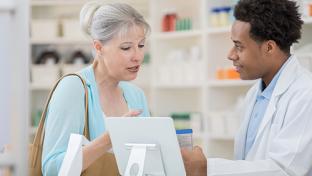Wegmans, Sam’s Club Continue to Top J.D. Power Pharmacy Study
When it comes to customer satisfaction with brick-and-mortar supermarket pharmacies, Wegmans Food Markets once more ranked highest overall, with a score of 915, according to the “J.D. Power 2019 U.S. Pharmacy Study.” Publix Super Markets came in second, with a score of 897 (it was third last year), and Southeastern Grocers banner Winn-Dixie was a close third, with a score of 896, ousting H-E-B from the top three (it was fourth this year, with a score of 894).
For brick-and-mortar mass-merchandiser pharmacies, Sam’s Club again ranked highest overall, with a score of 890, while Costco (879) and CVS/pharmacy inside Target (869) came in second and third, respectively for a second straight year. Among brick-and-mortar chain drug stores, Good Neighbor Pharmacy ranked highest overall, with a score of 914, followed by Health Mart (893) and Rite Aid Pharmacy (865).
What’s more, the annual study found that, despite the growing popularity of ecommerce, the U.S. pharmacy industry is still able to command high levels of customer satisfaction with both brick-and-mortar stores and mail-order providers like Humana Pharmacy, which ranked highest overall in this segment, with a score of 900, paced by Kaiser Permanente Pharmacy (886) and OptumRx (869).
“As technology companies promise to change the way Americans address their pharmacy needs, our data suggests that changing such entrenched behavior will be an uphill battle,” noted Greg Truex, managing director of health intelligence at Costa Mesa, Calif.-based J.D. Power. “Customers enjoy visiting their brick-and-mortar pharmacy, and they get a great deal of satisfaction from speaking directly with pharmacists. However, the potential for technology disruption is there. Although the frequency of use of digital solutions is low, early adopters are showing high levels of satisfaction.”
Findings of the 2019 study include the following:
- Face-to-face encounters still most common: Most pharmacy customers communicate with pharmacists and staff do so in person (89 percent), even though customers who use email or online live chat to interact with the pharmacist or staff are equally or more satisfied.
- Thorough pharmacist discussions lead to higher customer satisfaction: When pharmacists cover four or more topics with a customer in a discussion, satisfaction scores are above 940 on a 1,000-point scale, versus just one (884) or two (917) topics.
- Health-and-wellness customers spend more at the pharmacy: 42 percent of customers who are aware of their pharmacy’s health-and-wellness services have used one of the services in the past year. While those who’ve used these services spent 12.5 percent more on their most recent prescription order, considerably fewer health-and-wellness customers received a prescription as a result of their participation in 2019, as compared with 2018.
- Mobile app users more satisfied, but usage is flat: Just 20 percent of customers use a pharmacy’s mobile app, but those who do have satisfaction scores up to 23 points higher than those who don’t.
The “U.S. Pharmacy Study,” now in its 11th year, gauges customer satisfaction with brick-and-mortar and mail-order pharmacies. This year’s study is based on responses from 12,059 pharmacy customers who filled a prescription during the three months prior to the survey period of May-June 2019.






